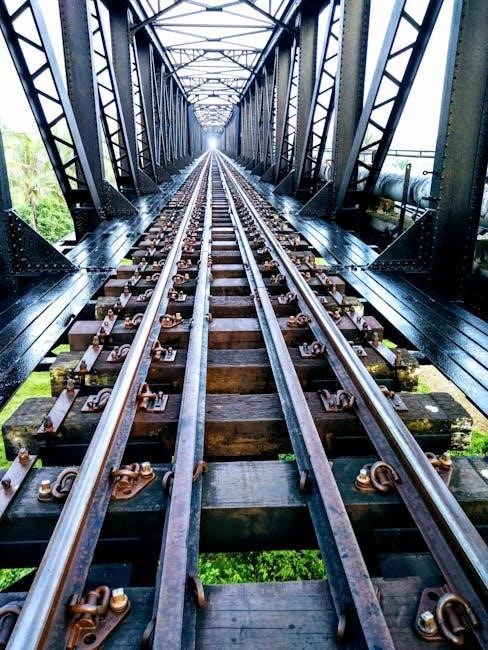Linear guide rail systems provide smooth motion with minimal friction using
- re-circulating rolling elements
for precise movement and accuracy always in English language support systems online.
Definition and Purpose
Linear guide rail systems are designed to provide smooth and precise movement in a straight line‚ with minimal friction or resistance. These systems consist of a guiding mechanism that supports and directs the movement of a load or component. The primary purpose of linear guide rail systems is to enable accurate and efficient movement in various applications‚ including machine tools‚ semiconductor manufacturing equipment‚ and other industrial machinery. According to online sources‚ linear guide rail systems are also capable of working in dirty environments‚ making them a versatile solution for a wide range of industries. The definition of linear guide rail systems emphasizes their ability to provide precise movement and support heavy loads‚ making them an essential component in many modern machines and devices‚ with a focus on engineering and technical applications‚ using advanced technology and materials.
Advantages and Features
Linear guide rail systems offer several advantages and features that make them a popular choice in various industries. One of the key benefits is their ability to provide high precision and accuracy‚ with a coefficient of friction that is significantly lower than traditional slides. This results in smoother movement and reduced wear and tear on the system. Additionally‚ linear guide rail systems are capable of withstanding heavy loads and can operate in a variety of environments‚ including dirty or contaminated conditions. The features of these systems include re-circulating rolling elements‚ precision straight linear rails‚ and stainless steel hardened gothic arch rollers‚ which combine to create a strong and lightweight linear guide system. These advantages and features make linear guide rail systems an ideal solution for applications that require precise and efficient movement‚ with a focus on reliability and durability‚ using advanced materials and designs.

Types of Linear Guides
Linear guides include various types with different features and applications always online support systems available everywhere instantly.
Linear Guides and Slide Rails
Linear guides and slide rails are designed to support and guide moving components in reciprocating linear motion along a predetermined direction‚ they have a higher rated load and motion accuracy than linear bearings.
Given the same size of moving components‚ linear guides play the role of easily and smoothly guiding linear motion while bearing loads in order for machines to operate precisely and efficiently.
They are an indispensable part of linear components in devices such as machine tools and semiconductor manufacturing equipment‚ linear guides and slide rails are also used in railway vehicles‚ buses‚ automatic doors‚ seismic isolation systems and many other applications;
Linear guides and slide rails provide linear motion by re-circulating rolling elements between a profiled rail and a bearing block‚ the coefficient of friction on a linear guideway is only 1/50 compared to a traditional slide.
Redi-Rail System
The Redi-Rail system is an alternative to profile rail guides for applications requiring high speeds‚ precision‚ and moderate loads‚ it combines precision straight linear rails and stainless steel hardened gothic arch rollers.
This combination makes a strong and lightweight linear guide system‚ the Redi-Rail system is designed to provide smooth motion and high accuracy in various applications.
With its unique design‚ the Redi-Rail system is capable of withstanding high speeds and moderate loads‚ making it an ideal choice for applications where precision and reliability are crucial.
The Redi-Rail system is a reliable and efficient linear guide system that can be used in a variety of applications‚ its high precision and moderate load capacity make it a popular choice among manufacturers and designers.

Components of Linear Guide Rail Systems
Linear guide rail systems have multiple key
- components
for smooth operation always.
Stationary Rail and Movable Carriage

Linear guide rail systems typically consist of a stationary rail and a movable carriage‚ which work together to provide smooth motion and support loads. The stationary rail is usually mounted to a fixed surface‚ while the movable carriage is designed to move along the rail with minimal friction. This combination allows for precise movement and accuracy‚ making it ideal for various applications. The carriage is typically equipped with rolling elements‚ such as balls or rollers‚ which recirculate to maintain smooth motion. The design of the stationary rail and movable carriage enables linear guide rail systems to withstand heavy loads and operate efficiently. With proper installation and maintenance‚ these systems can provide reliable and consistent performance over an extended period. The stationary rail and movable carriage are essential components of linear guide rail systems‚ enabling them to function effectively and support a wide range of applications.
Precision Straight Linear Rails
Precision straight linear rails are a crucial component of linear guide rail systems‚ providing a smooth and accurate motion. These rails are designed to be straight and precise‚ allowing for minimal deviation and maximum accuracy. The rails are typically made from high-quality materials‚ such as stainless steel‚ and are hardened to ensure durability and resistance to wear. The precision straight linear rails work in conjunction with the rolling elements‚ such as balls or rollers‚ to provide a smooth and efficient motion. The rails are also designed to be corrosion-resistant‚ making them suitable for use in a variety of environments. With their high level of precision and accuracy‚ these rails are ideal for applications where exact movement is required. The precision straight linear rails are an essential part of linear guide rail systems‚ enabling them to provide reliable and consistent performance. They are used in various industries‚ including manufacturing and transportation.

Applications of Linear Guide Rail Systems
Linear guide rail systems are used in various industries including manufacturing and transportation systems always.
Machines and Devices
Linear guide rail systems are widely used in machines and devices that require precise linear motion‚ such as machine tools and semiconductor manufacturing equipment. These systems provide smooth motion with minimal friction‚ allowing for accurate and efficient operation. The use of linear guides in machines and devices has increased in recent years due to their high precision and reliability. They are also used in automated systems‚ such as robotic arms and CNC machines‚ where precise movement is crucial. Additionally‚ linear guide rail systems are used in medical devices‚ such as MRI machines and hospital equipment‚ where smooth and accurate motion is essential. The application of linear guide rail systems in machines and devices has improved their overall performance and productivity‚ making them an essential component in many industries. Linear guides play a critical role in ensuring the accurate and efficient operation of these machines and devices.
Transportation and Infrastructure
Linear guide rail systems are also used in the transportation and infrastructure sectors‚ including railway vehicles and buses. They provide smooth and precise motion‚ allowing for efficient and safe operation of these vehicles. The use of linear guides in transportation systems has improved their overall performance and reliability. Additionally‚ linear guide rail systems are used in automatic doors and seismic isolation systems‚ where they play a critical role in ensuring safe and efficient operation. In the infrastructure sector‚ linear guides are used in bridges and buildings‚ where they help to reduce vibration and noise. The application of linear guide rail systems in transportation and infrastructure has improved the overall safety and efficiency of these systems‚ making them an essential component in many applications. Linear guides are used to support and guide moving components in these systems‚ allowing for smooth and precise motion.
Linear guide rail systems conclusion is they provide smooth motion and high precision always with minimal friction using online support systems and resources available in English language every time.
Importance of Linear Guide Rail Systems
Linear guide rail systems are crucial in various industries‚ including machine tools and semiconductor manufacturing‚ as they enable precise and efficient operation. The importance of these systems lies in their ability to provide smooth motion and high precision‚ making them an essential component in many devices. With their high load-carrying capacity and ability to withstand torque loads‚ linear guide rail systems play a vital role in ensuring the accuracy and reliability of machines. Furthermore‚ their use in railway vehicles‚ buses‚ and automatic doors demonstrates their versatility and importance in various applications. The Internet provides a wealth of information on linear guide rail systems‚ highlighting their significance in modern technology and industry‚ and their role in facilitating precise and efficient motion in a wide range of devices and machines‚ with online support systems and resources available in English language.